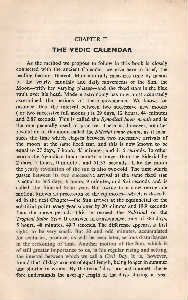Page 658 - Lokmanya Tilak Samagra (khand 2)
P. 658
CHAPTER II
THE VEDIC CALENDAR
As the method we propose to follow in this book is closely
connected with the ancient Calendar, we give here in brief, the
leading features thereof. Man naturally measures time by means
of the yearly, monthly and daily movements of the Sun, the
Moon-with her varying phases-and the fixed stars in the blue
vault over his head. Modern astronomy has now most accurately
ascertained the periods of these movements. We know, for
instance, that the interval between two successive new moons
( or two successive full moons ) is 29 days, 12 hours, 44 minutes
and 2.87 seconds. This is called the Synodical lunar month and is
the one generally used in practice. There is, however, another
revolution of the moon called the Siderial lunar month, as it mea-
sures the time which elapses between two successive arrivals of
the moon at the same fixed star, and this is now known to be
equal to 27 days, 7 hours, 43 minutes, and 11.5 seconds. In other
words the Synodical lunar month is longer than the Siderial by
2 days, 5 hours, 0 minute , and 51.37 seconds. Like the moon
the yearly revolution of the sun is also two-fold. The time which
passes between its two successive arrival at the same fixed star
is equal to 365 days, 6 hours, 9 minutes, and 9.6 seconds and is
called the Siderial Solar year. But owing to a slow retrograde
motion, known as precession of the equinoxes-which is describ-
ed in the next Chapter-the Sun arrives at the equinoctial or the
solstitial point every year sooner by 20 minutes and 19.9 seconds
than the above period. This is termed the Solstitial or the
Tropical Solar Year. It consists, in consequence, otily of 365 days,
5 hours, 48 minutes, 49.7 seconds. The difference appears, at first
sight, to be very small. But 20 and odd minutes, accumulated
for centuries, produce, as will be seen later, serious disturbances
in the reckoning of time. Another motion of the Sun, which is
of still greater importance to us, is his regular rising and setting,
the interval between which we call a Civil Day. It is, however,
found that all days are not of equal length, being longer in summer
and shorter in winter. By the term 'day' an astronomer there-
fore understands the average length of the days during a year

